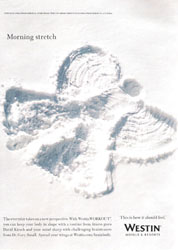





| Jessica Jackson |
| Visual Communication |
| May 2008 |
 |
 |
 |
 |
 |
 |
|
Travel advertisements in American women's magazines seem to target a broad audience, even within a particular magazine. And yet, when several advertisements from several different magazines are analyzed together, similar patterns appear; particularly in the way that interpellation is used. Travel advertisements in women's magazines use interpellation--through both words and images--to hail the viewer by tapping into their inner desires and promising to fulfill them. On the various pages of this website, I will analyze the ways in which travel advertisements in women’s magazines interpellate viewers as subjects, and particularly the way that discourse comes into play in this process. I will incorporate the discourses of women's magazines as a genre, and discourses of travel as well as the discourses of particular magazines, such as health/fitness or the South. But first, let me clearly explain my main theoretical approach: interpellation. Interpellation, or appellation, as some have called it, is essentially the process through which the viewer or reader is created by the ad. Obviously, it is much more complex than that, as multiple theorists have explained, but interpellation is the way that an advertisement gets the attention of the viewer, or targets its (pre-defined) audience. Louis Althusser, the Marxist philosopher who originally coined the term in his 1969 essay, "Ideology and Ideological State Apparatuses," defines interpellation in this way: "I shall then suggest that ideology 'acts' or 'functions' in such a way that it 'recruits' subjects among the individuals (it recruits them all), or 'transforms' the individuals into subjects (it transforms them all) by that very precise operation which I have called interpellation or hailing, and which can be imagined along the lines of the most commonplace everyday police (or other) hailing: 'Hey, you there!'" (Althusser 174). Through ideology, individuals are interpellated as subjects (Durham and Kellner 84-85). Althusser explains that ideology is knowledge that legitimates unequal power structures, or "an imaginary relation to real relations" (Durham and Kellner 82). In order for ideology to interpellate individuals as subjects, advertisements must use ideology in order to hail readers, catching their attention in a way that they know that the ad is directed at them, therefore transforming them into the subject of the advertisement. Althusser points out that "hails" rarely ever miss the person that they are directed toward, which means that interpellation in advertising is usually effective in reaching its intended audience (Althusser 174). After Althusser, Judith Williamson also theorizes about interpellation, but she calls it appellation. Because of the diversity in terminology used to refer to this approach, I intend to use the term "interpellation" for the majority of the project unless specifically referring to a theorist or text in which the term "appellation" is used. Here, Williamson describes the way that appellation is used in advertising: "Every add necessarily assumes a particular spectator: it projects into the space out in front of it an imaginary person composed in terms of the relationship between the elements within the ad. You move into this space as you look at the ad, and in doing so "become" the spectator, you feel that the 'hey, you' 'really did' apply to you in particular" (Williamson 50-51). Appellation acts in order to pull a viewer into the "signifying effects" of an advertisement (Rose 100). Through Williamson’s appellation, the self is constructed according to the messages portrayed in the advertisement--the viewer is told that they are unique, and able to make choices, thus disciplining the viewer into making the choice that the advertisement encourages (Williamson 53). Williamson also explains that an advertisement cannot have meaning on its own; the presence of a viewer creates significance. "Our creation of meaning in the ad, as active-receivers, and its appellation of us, as subjects, are synonymous and simultaneous. In reading the ad--'People like you'--we give it significance: it cannot have significance until we appear in front of it" (Williamson 55). Williamson also suggests these main ways in which an ad captures the attention of the viewer: spatial organization, visual absences, content of written text, visual puns or puzzles, and calligraphy (in which the product becomes a word) (Rose 100). Mojca Pajnik and Petra Lesjak-Tusek, although not theorists on interpellation, use it insightfully in their analysis of Slovenian mobile telephone advertisements. Their description of interpellation clearly pulls from Althusser's work: "There is a discourse of the inner voice used in advertisements that addresses the reader as 'you,' continuously telling you what it is you want and need; advertising, as an ideological practice, interpellates individuals as subjects" (Pajnik and Lesjak-Tusek 279). Another scholar, Ray Udeajah, uses appellation in a different way in his work on Nigerian television broadcasting. He defines appellation as a "system of names" and refers to slogans for broadcast stations as "appellations" (Udeajah 75). Although different, this approach works, because a slogan is simply a way of catching a viewer’s attention, or hailing them, which is appellation--Udeajah simply talks about it in a different way, which can be translated into print advertising as well. In my study of print advertisements about travel in women’s magazines, I found that in magazines such as Good Housekeeping, Southern Living, and Woman's Day, many travel advertisements were present, interpellating different sorts of people. Not every travel advertisement in the same magazine was directed at all readers, or the same reader. Instead, a range of advertisements appeared, interpellating the range of possible readers. These three magazines seem to target a broad readership, ranging from young moms with small children to retired moms with grown children and everything in between. Clearly, the advertisements in these magazines will be more diverse than in another magazine with a narrower readership, or even one with a more specifically young readership, like Redbook or Self--both of which had few travel advertisements, all of which were targeted at the same audience. I divided the advertisements into categories based on approach: furthering relationships and escaping. Ads interpellating a subject who is focused on furthering relationships are those for Colorado, Missouri and Alabama, found in Woman's Day, Good Housekeeping, and Southern Living, respectively. And those interpellating a subject who desires to escape from the everyday are Carnival Cruise Lines, Holland America Cruise Lines, and Westin Hotels and Resorts, found in Redbook, Real Simple and Self, respectively. This is coincidentally a division by magazine type as well. Of the six magazines that I chose, Good Housekeeping, Southern Living and Woman's Day are most alike,while Redbook, Self and Real Simple are different from the other three as well as one another, but have a more similar target audience than any of these compared with the other group. On subsequent pages, you will find images of these advertisements as well as in-depth analysis of their use of interpellation. |
| Interpellation: Furthering Relationships | Interpellation: Escaping from the Everyday |
a class taught by Bob Bednar in the Communication Studies Department at Southwestern University